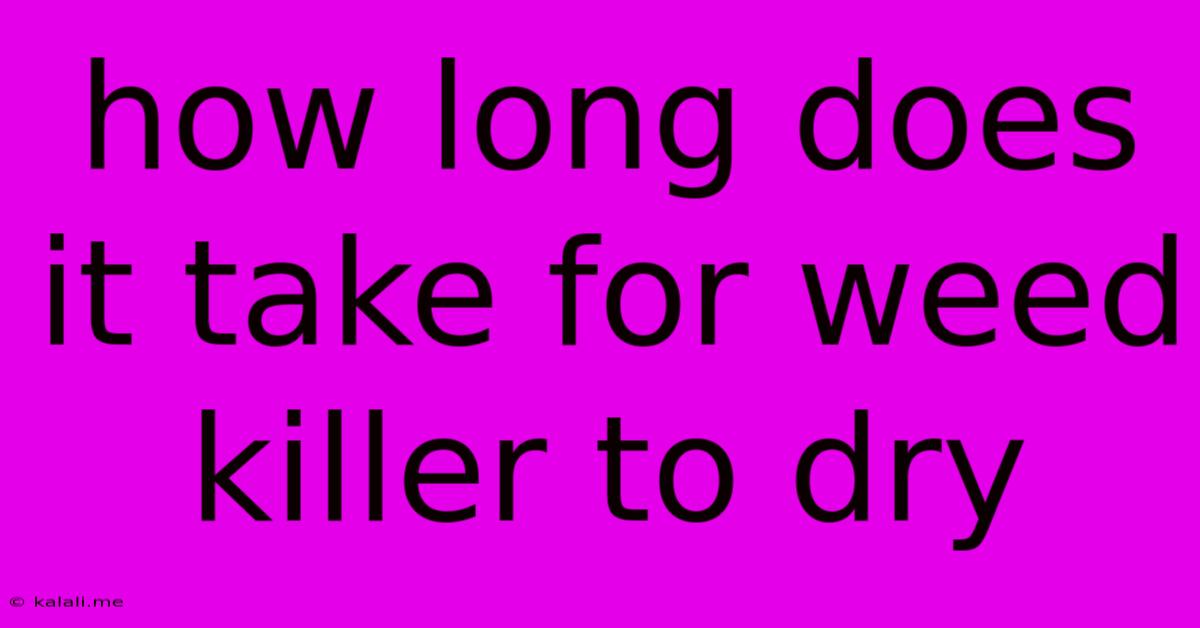How Long Does It Take For Weed Killer To Dry
Kalali
May 30, 2025 · 3 min read

Table of Contents
How Long Does it Take for Weed Killer to Dry? A Comprehensive Guide
Meta Description: Wondering how long weed killer takes to dry before you can safely resume activities? This guide explores drying times based on product type, weather conditions, and application methods, ensuring your safety and the effectiveness of your weed control.
Choosing the right weed killer is only half the battle. Understanding how long it takes to dry completely is crucial for protecting your family, pets, and the environment. The drying time isn't a fixed number; it depends on several factors, and getting it wrong can have consequences ranging from minor skin irritation to damage to your lawn. This article breaks down everything you need to know about weed killer drying times.
Factors Affecting Weed Killer Drying Time
Several factors influence how long a weed killer takes to dry. These include:
-
Type of Weed Killer: Different formulations dry at different rates. Liquid concentrates typically dry faster than granular products. Pre-emergent herbicides, designed to prevent weed growth, often have longer drying times than post-emergent herbicides that kill existing weeds. The specific active ingredient also plays a role; some are formulated to dry quickly, while others require more time.
-
Weather Conditions: Sunshine, wind, and temperature significantly impact drying time. Hot, sunny, and windy conditions will accelerate drying, while humid, overcast days will prolong it. Rain, of course, will dramatically increase the drying time and may even wash away the herbicide before it's had a chance to work.
-
Application Method: Spraying weed killer will generally result in a quicker drying time than using a granular application. The spray covers a larger surface area, allowing for more rapid evaporation. The amount applied also matters; a heavier application will naturally take longer to dry than a lighter one. Furthermore, the surface area being treated influences the drying time; a large, flat lawn will dry faster than a densely planted flowerbed.
-
Product Concentration: A stronger concentration of the weed killer solution may require a longer drying time. Always follow the product label's instructions regarding dilution ratios for optimal results and safety.
Typical Drying Times for Different Weed Killers
While there's no universal drying time, here's a general guideline:
-
Liquid Spray Herbicides: Under ideal conditions (sunny, warm, and breezy), liquid weed killers can dry within 1-3 hours. However, in less ideal conditions, this could easily extend to 4-6 hours or even longer.
-
Granular Herbicides: Granular herbicides take longer to dry, as they need to absorb moisture from the soil and then release their active ingredients. You should expect a drying time of at least 6-8 hours, potentially longer depending on the weather.
-
Pre-emergent Herbicides: Because these are designed to work over a longer period, their drying times are less critical. However, it's generally recommended to wait at least 24 hours before watering or significant rainfall.
Safety Precautions: When is it Safe to Return?
Regardless of the estimated drying time, it's crucial to prioritize safety. Here are some essential precautions:
-
Always read the product label: The label will provide specific drying time recommendations and safety precautions for that particular herbicide.
-
Keep children and pets away: Until the weed killer is completely dry, keep children and pets off the treated area to prevent accidental contact.
-
Wear protective gear: Always use gloves, eye protection, and appropriate clothing when applying weed killers.
-
Avoid contact with skin: If you do get weed killer on your skin, wash the area thoroughly with soap and water.
-
Wait for dew to dry: Do not apply weed killer when dew is present, as this will slow down the drying process and reduce the effectiveness.
Conclusion
Understanding how long weed killer takes to dry is critical for effective weed control and personal safety. Always prioritize safety by carefully reading the product label, following application instructions, and waiting the appropriate amount of time before returning to the treated area. Remember that weather conditions play a crucial role, so adjust your expectations accordingly. By paying attention to these factors, you can ensure successful weed control without compromising your safety or the health of your lawn.
Latest Posts
Latest Posts
-
Galvanized Pipe To Pvc Pipe Connection
May 31, 2025
-
How To Install Bpftool Command In Linux
May 31, 2025
-
How Much Water Does A Water Softener Use
May 31, 2025
-
How Much Termite Damage Is Too Much
May 31, 2025
-
Red White Black Wires Ceiling Light
May 31, 2025
Related Post
Thank you for visiting our website which covers about How Long Does It Take For Weed Killer To Dry . We hope the information provided has been useful to you. Feel free to contact us if you have any questions or need further assistance. See you next time and don't miss to bookmark.